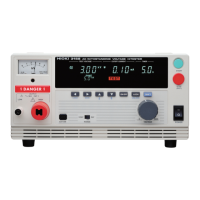40
────────────────────────────────────────────────────
3.5 PASS or FAIL Determination
────────────────────────────────────────────────────
3.5.3 "FAIL" State
WARNING
Even when a test has been terminated, there may still be voltage in
the output-voltage terminal when the DANGER lamp is lit. Before
touching the output-voltage terminal, test lead, or tested object, make
sure the analog voltmeter is at 0 kV, the DANGER lamp is OFF, and
the TEST lamp is OFF.
・
The FAIL state is held using the FAIL Hold function. Refer to Section "4.2 FAIL Hold Function".
If the measured voltage deviates from the upper- or lower-level value during the test,
the unit switches to the FAIL state and immediately stops outputting a voltage. The
FAIL state can be divided into UPPER FAIL and LOWER FAIL states.
・
UPPER FAIL indicates that the measured voltage has exceeded the upper-level
value.
・
LOWER FAIL indicates that the measured voltage has dropped below the lower-
level value.
(When the lower-level value is set to OFF, LOWER FAIL is ineffective.)
With a comparative voltage value set, if the output voltage deviates from the
comparative-voltage range, the unit switches to the FAIL state and UPPER,
LOWER,andFAIL light up.

